Church History
Parish History
- Chapter 1 – Pre 1840-1885 “Beginnings”
- Chapter 2 – 1885-1889 “Dedication”
- Chapter 3 –1889-1894 “Building”
- Chapter 4 – 1895-1933 “New Beginnings”
- Chapter 5 – 1933-1956 “The Middle Years”
- Chapter 6 – 1956-1981 “A New School”
- Chapter 7 – 1981-2000 “Renovation”
- Chapter 8 – 2001-present “A New Direction”
Chapter 1 “Beginnings”
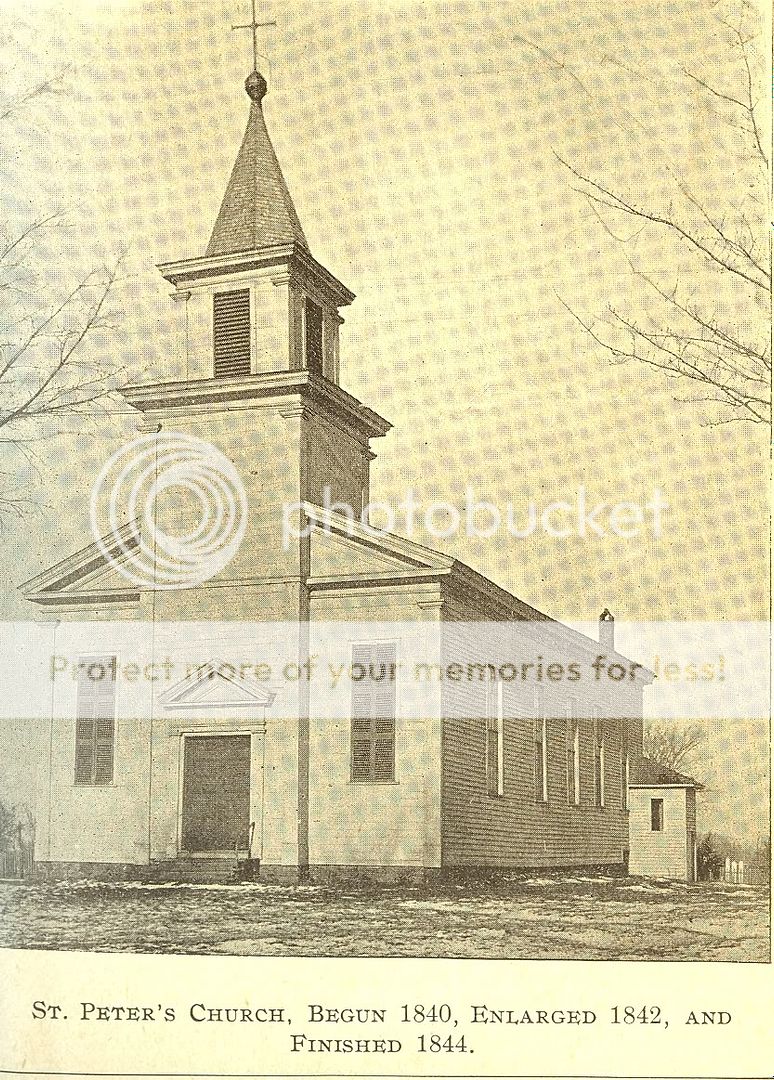
The first Catholic Church was built in Norwalk on west Main Street in the year 1841. Prior to the building of St. Peter’s church, the people of Norwalk had to attend Mass at St. Alphonsus, in Peru. St. Alphonsus had been established about 1828. Click here for their website.

Father Narcissus Ponchell came to St. Peter’s as pastor in 1855. Under his guidance the English speaking Catholics organized under the patronage of St. Mary, The Mother of our Redeemer in the summer of 1856. The people of the congregation were few and poor so construction of a church could not begin until the following year 1857.
Shortly before the first railroad was built through Norwalk, which was in the early 1850’s, there was a large influx of Irish people into Norwalk. They came to work on the railroad. Most of the newcomers settled in the northwest section of town, and attended Mass at St. Peter’s. Separate services were held in English and German for the two nationalities attending the church. The English speaking Catholics wished to have a parish of their own and so on October 12, 1853 a tract of land was bought on Milan Avenue at what is now the corner of St. Mary’s Street and Milan Avenue. The 60ft. by 300ft. lot cost $200.00.

Father Ponchell was appointed pastor of the new parish. He completed the exterior of the church at the cost of $8000.00. The interior of the church was not yet complete when the first Mass was celebrated on Easter Sunday, 1859. The church was a brick structure measuring 60 by40 feet, and was located at the corner of Milan Avenue and St. Mary’s Streets.
Father Ponchell died on September 15, 1860 without seeing the completion of his church. It had been his request that he be buried under the church he had worked so hard to build. A marble slab was placed in the wall directly over his grave with this inscription:

Erected By This Congregation
In Grateful Memory
Of The
Rev. Narcissus Ponchell,
Born At Hermelinghen, France, September 19, 1825.
Who By His Zeal Erected This Church
And Was its First Pastor
Died September. 15TH, 1860
Aged 35 years.
May His Soul Rest In Peace. Amen.


Reverend John Quinn had charge of St. Mary’s from 1860 to 1864. The church was completed in 1861. Father Quinn bought five acres of land on east Main Street for $355.00 in March of 1862, for use as a cemetery. Bishop Rappe blessed the cemetery a few months later. Father Quinn also started to build a two story parochial residence on the southeast corner of Milan and St. Mary’s Streets. This house is still there today.

Reverend Thomas P. Thorpe was appointed pastor of the parish in the early summer of 1864. During his four years as pastor, the rectory started by Father Quinn was completed for $3000.00. A school was built at the rear of the church for $4000.00 in 1865.(note, the building behind the church with a cross on it.) There were 80 students at the start of school. Father Thorpe left Norwalk in March of 1868.


Father Thomas Halley became the new pastor on March 3, 1868. A bell weighing 3100 pounds was purchased in 1869 for $1400.00. The bell’s tone was clear and often could be heard at a distance of eight miles.

Seeing that the growing parish was in need of a larger church and school, a tract of land was bought at State and League Streets for $3800.00 in March of 1875. This property was one mile west of the old church. A new two-story brick school was built on this property in 1878 even though the church remained on Milan Avenue. The school measured 60X40 feet and had four large rooms on the first floor and a large hall on the second floor. The total cost of the school was $8,000.00.
Father Halley died in Norwalk on January 4, 1885, and is buried in St. Mary’s cemetery.(picture of his gravestone….close up view)When Father Halley died, the parish, which started in 1856 with 30 families, now numbered 130 and was free of debt.
Father Charles V. Chevraux was appointed by the bishop on January 7, 1885 to succeed Father Halley. The Sisters of St. Joseph took charge of the school in September of 1886. The attendance at that time was 100 children.
Chapter 2 “Dedication”


Because the parish church was now too small and no longer centrally located, the congregation decided it was time to build a new and larger church. Early in the spring of 1889, plans prepared by William P. Ginther of Akron, Ohio, were submitted to the Bishop for approval. On April 3, 1889, the Bishop gave permission to begin work on the new church. Note!! William P. Ginther also designed Sacred Heart Church in Bethlehem, Ohio. See the similarities between it and St. Mary’s??
Ground was broken on the 29th day of May. The men of the parish did the excavation. The pastor made an appeal to them and from 20 to 30 of them responded every evening for about a week. The first stone was laid on the 12th of June. The foundation was completed by the first week of September by Marg & Griffin, of Fremont for $1928.30.
The cornerstone was laid on September 22, 1889, with impressive ceremonies. A parade started from the old church and proceeded to the foundation of the new church at State and League Streets. Over a thousand people came from surrounding towns including Monroeville, Bellevue, Fremont, Toledo, Elyria, Cleveland, and Sandusky. The Right Reverend Richard Gilmour blessed the area where the altar was to stand and then laid the cornerstone and blessed the foundations of the church.
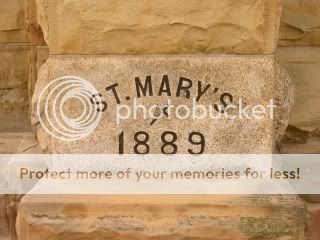
Chapter 3 “Building”
Work now started on building the church itself. John Parker and Sons of Norwalk got the contract for $10,974.00. For this amount of money they agreed to get the building including the tower, ready for slating, furnishing all materials and labor. The slate, galvanized iron, and the large door and window frames were not included in the contract. One of the chief stonemasons for Mr. Parker was Clement Cazeau, a member of St. Mary’s parish.
Due to good weather the stonemasons worked until December of 1889, finishing the sacristy walls and running the other walls ten feet above the water table. The stonework was completed in 1890. The steeple was slated during the summer of 1891. The steps were placed in front of the church in 1892 for $900.00. In the spring of 1893 the bell was moved from the old church and placed in the tower. (Note: There is no steeple in this picture of the old church. It was removed after the bell was taken out.) The interior of the church was plastered in the summer of 1893 for $3710.00 and frescoed for $900.00. The church was completed in 1894. The church measures 120 ft. long by 55 ft. wide, is cruciform and Gothic in style.
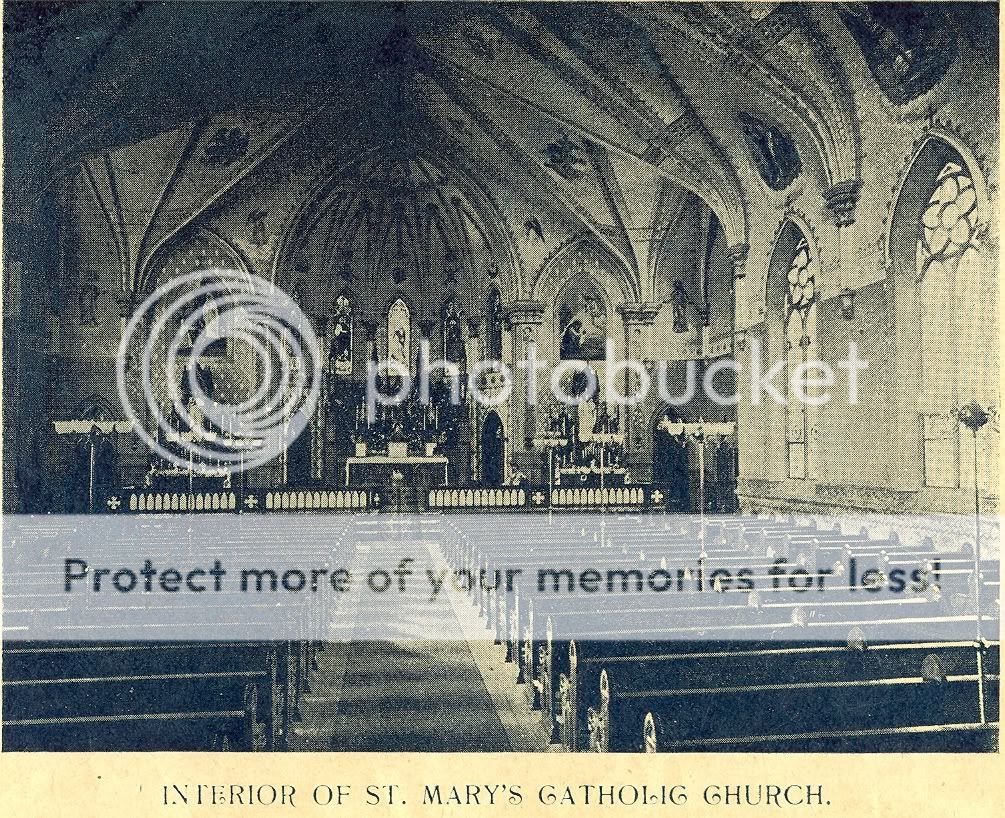


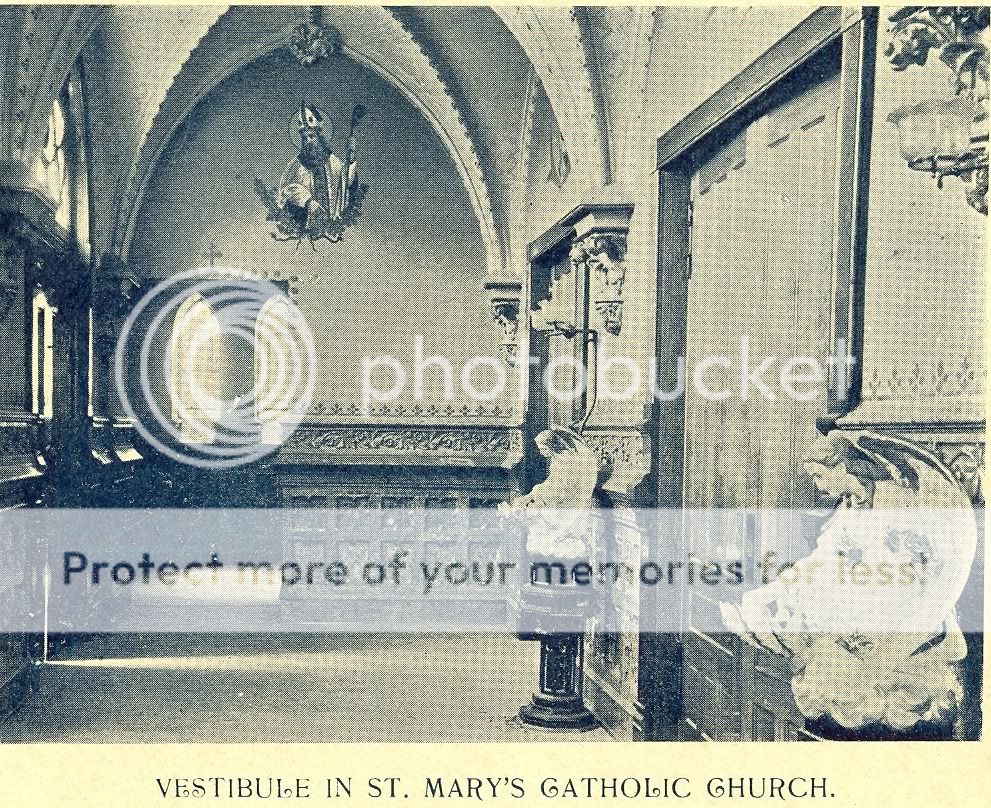
The altars, pews, confessionals, Communion rail, and gallery are done in Antique oak. One cannot fail to notice the beautiful carving above the tabernacle. The altar on the left contains a beautiful statue of the Blessed Virgin and the altar on the right contains an excellent statue of St. Joseph. The two statues were made in Paris, France and are fine works of art. The stained glass windows were done by the H. M. Hooker Company of Chicago and cost $3,000. The large window in the south transept represents the Nativity and was a gift of the Young Ladies Sodality. The window in the north transept represents the Annunciation. This window is dedicated to the memory of the three former pastors: Revs. Ponchell, John Quinn and T.F. Halley. The five sanctuary windows are of the four evangelists (Matthew, Mark, Luke, John) and Mary. The nationality of the congregation was not forgotten in building the church. Saint Patrick is represented on one of the stained glass windows (the picture on the right) and there was also a painting of St. Patrick on one of the walls of the vestibule. All of the windows in the main area of the church have a picture of a saint on them. All those windows looks as such, but with different saints portrayed on them.
The building was heated by steam and the lighting by gas using standard lights proved a great success. (Note: The Chandeliers hanging from the ceiling at the top of the picture. Also, the poles with white things at top at the bottom of the picture.) The total cost of church and furniture was $35,000.00. The church was filled to overflowing at the dedication ceremony on September 2, 1894. Bishop Hortsman consecrated the church. The reverend L. Brady, a son of the parish, and newly ordained in 1893, helped celebrate the Mass. He is also buried at St. Mary’s Cemetery. His gravestone.

Chapter 4 “New Beginnings”
Father James Quinn took charge of St. Mary’s in the fall of 1897. He remained in charge until January of 1900. Fr. Quinn worked to reduce the parish debt during his years at St. Mary’s.

Father Francis Malloy took charge of the parish in 1900. He continued to pay on the parish debt and was remembered for his spiritual care of the souls committed to him. He served until the year 1904.

Father P.J. Quinn came to St. Mary’s in 1904. The old church on Milan Avenue was sold to private owners in 1905. Also in 1905 the Sisters of St. Dominic of Adrian, Michigan took charge of the school.
The old church on Milan Avenue was torn down in 1906. The remains of Father Ponchell, who was buried beneath the church, was moved to St. Mary’s cemetery.(gravestone) (Also, read this article about Father Ponchell’s burial moving. very interesting!!) Father Quinn undertook the building of a new rectory next to the church. The two-story stone residence was completed in 1907, and cost $15,000.00. Some of the bricks from the old church on Milan Avenue were used in the building of the new rectory. Until this time the pastors had still been living in the old rectory on Milan Avenue next to the old church.


In 1910 the Reverend Joseph O’Keefe took charge of the parish. A new bell was purchased in the year 1912 because the old bell had cracked. The new bell weighed nearly 2000 pounds and bore the following inscription: ”In 1912, purchased to replace bell bought in 1869”
Early in the fall of 1913, it was discovered that one wall of the school was sagging away from the window frames. The condition was made known to the Bishop. The building was inspected and deemed unsafe. There were 70 children attending the school at that time. The students were sent to the public schools until a new school could be built.
In 1914 Reverend P.J. Clancey was placed in charge of the parish. Being in poor health he remained in charge until May of 1917.

Father Charles Gardner was transferred to St. Mary’s on May 9, 1917. In 1918 the exterior of the church was repaired. The interior of the church was frescoed and the Stations of the Cross were donated and installed in 1919. A new two room wooden school was also built in 1919. The cost of the school was $10,000.00. The Sisters of St. Dominic took charge of the school in the fall of 1919.
A new pipe organ was installed in honor of Father Gardeners 25th Anniversary to the Priesthood. Mrs. Elizabeth Picker donated the chimes. The cost of the organ was $5,000.00.

Chapter 5 “The Middle Years”
Father John Malone, born and raised in the parish, was ordained on June 10, 1933. He offered his first Mass on June 11, 1933.
Due to the poor condition of the Sister’s house, the mother Superior ordered the Sisters withdrawn from St. Mary’s in June of 1934. The following September two lay teachers opened the school. They were Miss Helen Carr, and Miss Clara Fagen.
Father Gardner died at St. Mary’s on January 15, 1935.
Father Henry Foran came to St. Mary’s from Willard, Ohio, in February of 1935. He asked the Sister’s of Notre Dame to take charge of the school in August of 1935. The sister’s resided with the St. Paul sisters. Father Foran did necessary repairs to the church and rectory. He also worked to reduce the parish debt. He left the parish in December of 1936.
Father Thomas Quinlen came to the parish as pastor in December of 1936. New carpet was installed in the church sanctuary in May of 1937. Repairs started by Father Foran continued.
Archbishop Vehr from the Denver Diocese, ordained Father Charles Sanger, a son of the parish. He offered his first Mass at St. Mary’s on May 30, 1937. Bishop Altar ordained Father Carmen Nardechia, another son of the parish, on Sunday May 1, 1938. He offered his first Mass at St. Mary’s on Sunday May 8, 1938.
The vestibule was remodeled and the statues were all repainted in 1941. During World War II the pastor served as a member of the ration board for tires and gas, and donated the use of the school for issuing the various ration books.
The pipe organ was rebuilt in August of 1944. The pipe organ was 20 years old. The golden anniversary of the church was observed but due to the war the celebration was kept simple.
Father Quinlen was sick during much of 1947 and Father Geppert came to St. Mary’s to help out.
Mary Ellen Fry entered the convent of the Sisters of St. Dominic in Caldwell, New Jersey in February of 1951.
The church was rewired and the present lighting fixtures were installed in April of 1952 for $4000.00.
The estate of Mary Sattig left a 109-acre farm on Lovers Lane to the parish in 1952. The hired hand had a life lease on the farm so the parish could not take possession of the land until his death.

A severe windstorm did $12,000 damage to the church and steeple. It was at this time that all of the decorative metal work on the steeple had to be removed.

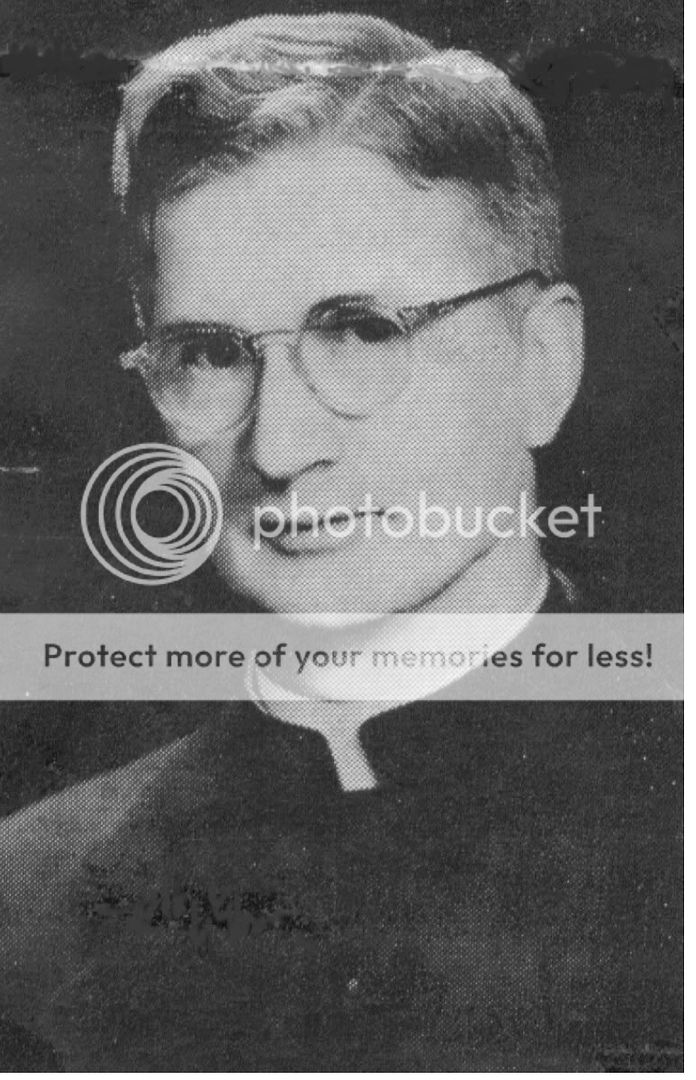

Father Quinlen was transferred and Father Thomas E. Reynolds became pastor at St. Mary’s on October 14, 1953. Renovation of the church started in November of 1953 and was completed in October of 1954. The five sanctuary windows were bricked over on the inside. The confessionals were removed from the front of the church. The decorative wainscoting below the windows was removed. Storm windows were installed on the church. The sanctuary was enlarged and the side altars were cut down. The National Art Studio of Kewaunee, Wisconsin, frescoed the church. A new gas furnace replaced the old coal fired furnace. Andrew Mcguan donated an electric bell ringer for the church. New steps were installed in front of the church in 1955. New sidewalks were also installed around the church. The playground on the north and south of the school was blacktopped.

Father Reynolds suffered a heart attack in October of 1956. Father Norbert Howe was sent to St. Mary’s as assistant pastor.
Chapter 6 “A New School”
The two-room wooden school was becoming too small for the growing parish. Some classes had to be held in the church sacristy and the old sister’s house. Fr. Quinlen had wanted to build a new school during his pastorate but due to his poor health had been unable to. It was decided that a new school had to be built. To make room for the new school, the old sisters house was sold and the house moved to it’s present location on Baker Street. Ground was broken for the new school on May 18, 1957. The school was completed in the spring of 1958. The building contained five classrooms and a multipurpose room that could be converted into three additional classrooms when needed. The total cost of the building and equipment came to $240,000.00. The school was dedicated on June 8, 1958.

Bishop George T. Rehring conducted a Pontifical High Mass at St. Mary’s in May of 1960 as part of the one hundredth anniversary of the parish. The theme of the Centenary year was “Honor and Glory to Almighty God through Mary, Patroness of the church.” One of the highlights of the Centenary year came in December at a closing dinner when Father Reynolds announced that the debt for the school had finally been paid off.
The original slate roof on church was replaced in 1963. Repairs were also made on the steeple. Work was begun in April of 1963 on an auditorium-gym for the school. Volunteers did some of the work including grading, preparing the floor, and painting. The gym measures 50 by 100 feet. It was dedicated on September 15, 1963. There were 165 students in the school at that time.

Ground was broken in 1964 for a new rectory. The cost of the rectory was $50,000.00. The priests moved into the rectory in December of 1964. During 1965 the old rectory was remodeled into a convent for the Sisters of Notre Dame who had been staying at St. Paul’s in the past. A new roof was put on the convent and a passageway was built between the convent and the church. Five sisters took up residence in the fall of 1965.


The interior of the church was painted in March of 1966. The original symbols painted in 1954 were kept but every thing else was repainted. Also in 1966 the old two-room was torn down and the area blacktopped. Father Reynolds celebrated his 40th anniversary to the priesthood in June of 1966. Father Howe, who had been an assistant at St. Mary’s since 1956 was transferred to Lima St. John’s. Father John Bishop was sent as a summer replacement. He remained until September when Father Drouilard came to St. Mary’s. Father Drouilard left in October to become pastor at Hamler. Father Dennis Schroeder became assistant pastor on October 26.
A parishioner donated a stainless steel cross. The new cross was installed on the steeple of the church in 1969.

Father Schroeder was transferred to Fostoria in January of 1970. Father Herman Scherger replaced him.
The Bishop granted permission in May of 1970 to build an addition to the school. This included an art room, library, music room, and a meeting room. The cost of the addition was $100,000.00. Work was completed in October of 1970.
Saint Alphonsus parish became sister parish of St. Mary’s in June of 1970.
Father Scherger was transferred in July of 1971 and Father Thomas Ankenbrandt became assistant pastor.


Father Bertrand Schenk became the new pastor of the parish in June of 1972. Father Ankenbrandt was also transferred and not replaced.
The heating system in the convent was replaced in September of 1974 for $5700.00. The metal work on the church and the window frames were repainted for $7800.00

The large field across from the rear of the school was purchased from the estate of Mrs. Clarence Hipp for $15,000.00 in January of 1975. A new heating system was installed in the church during the summer of 1975. The old system was in such bad shape that a new boiler room was built near the sacristy. The new system is of the hot water baseboard type and cost $18,450.00. The old system was eventually torn down.

Father Schenk celebrated his 50th Anniversary to the priesthood on May 15, 1977. Father Reynolds celebrated his 50th Anniversary to the priesthood at St. Mary’s church on June 12, 1977. Father Schenk left St. Mary’s to become the Chaplain of the Ohio Soldiers and Sailors Home in Sandusky at the end of June in 1977.
Father J. Norbert Howe became pastor on June 30, 1977. Father Howe had been assistant pastor at St. Mary’s from 1956 – 1967. Father Reynolds died on September 28, 1977. The funeral Mass was held at St. Mary’s church.
A new roof was installed on the school in August for $26,700.00. The church windows were covered with Lexan storm windows in July of 1980 for $25,000. Work was begun on renovating the organ in December of 1980. The parish decided to start a kindergarten class at St. Mary’s. The first class was begun in the fall of 1981.
Father Howe celebrated his 25th Anniversary to the priesthood on May 17, 1981.
Chapter 7 “Renovation”
The church sacristy was remodeled for $2700.00 in January of 1982.

Estimates received on rebuilding the pipe organ were too high and so a new electronic organ was purchased for $25,000.00. The new organ was dedicated on February 14, 1982. Also in 1982 parishioners pledged $91,000.00 to sandblast (note how dirty the bricks are) and tuck-point the church and convent and to install an artificial slate on the church steeple. The work was completed in January of 1983. Work was begun in June of 1983 to close off the top sections of the school windows to conserve energy. The cost was $11,000.00. A piece of property directly behind the school on Baker Street was purchased for $17,000. The house on the property was torn down.


Father Howe was transferred to Tiffin on July 6, 1983. Father Raymond Fisher took over the pastorate of St. Mary’s parish. Father Fisher made the parish house more open for use for meetings for parishioners. St. Mary parish celebrated its 125th Anniversary as a parish in 1985. The theme for the Jubilee was “growing together in Faith and Fellowship – Yesterday, Today, and Tomorrow” 1860-1985. The closing of the Jubilee year was celebrated with Bishop Hoffman on December 8th 1985. Also during 1985 the Sisters of Notre Dame celebrated 50 years of service to St. Mary’s School. There was a special Mass on Sunday September 29, 1985. All of the Sisters who taught at the school over the last 50 years were invited.
A
committee was formed in 1987 to begin to study the possibility of
renovating the church. Father Fisher was transferred to Toledo in July
of 1987.
The
Reverend Herbert Willman became the new pastor of St. Mary’s in July of
1987. New ceilings and lighting fixtures were installed in the school.
During Father Willman’s pastorate more study was given to the renovation
of the church. Father Willman was transferred to St. Paul’s parish in
September of 1988.

The Reverend Michael Schelling became pastor in October of 1988. Jack Bleile was ordained as permanent deacon at St. Mary’s on December 18, 1988.

New lighting was installed in the school gym during the summer of 1989. Also during 1989 a new hot water heating system was installed in the school to take care of the needs of the NE section of the school building. This took some of the load off the old steam boiler. The cost of the new system was $37,000.
The Sisters of Notre Dame began living with the St. Paul Sisters in the fall of 1989. This provided the Sisters with a bigger religious community. Since the convent was no longer being used as a residence for the Sister’s, it was reopened on November 1, 1989 as a meeting or conference facility and was renamed “The Century House”.
The Sisters of Notre Dame would not be able to provide a principal for the school any longer and so Mrs. Joy Tremmel was hired as the new principal in the fall of 1990.
Work began on the stained glass windows in the church on April 10, 1991. The large transept windows were removed, and taken to Cleveland where they were cleaned, repaired, and re-leaded.
The passageway connecting the Century House and the church was removed in January of 1992. The Century House was remodeled in the spring of 1992 so it would be ready to be used as a preschool in the fall of 1992.
Work was begun in February of 1993 to open the five Sanctuary windows in church. These windows had been bricked over in 1954. Volunteers from the parish did the work. The five windows were removed in August for re-leading and other repairs and were returned in December of 1993. The side windows in church and the vestibule windows were also removed during the summer of 1993. These windows were cleaned and repairs made as needed. The large choir loft window was completely replaced. The total cost of the windows came to $61,000.

Father Schelling was transferred in July of 1994 and Father Nelson Beaver became pastor of St. Mary parish. Renovation of the church began in 1996. The sanctuary area was made smaller, with the left side used for the choir and the right side for additional seating and an area set-aside for the baptismal font. The ceiling was re-plastered and the interior of the church was repainted. New flooring was installed. The benches were refinished and reconfigured. The organ was moved downstairs. The old organ and pipes were removed. New carpeting was installed in the sanctuary and the sacristies. The total cost of the renovation was $255,000.00.
Chapter 8 “A New Direction”
The church was air conditioned in 2001 for $69,000.00.

During 2002 a new playground was added across the street from the rear of the school. A garden and enrichment center was developed directly behind the school.


During the fall of 2003 the roof of the church was replaced for $55,000.00.
Father Beaver was transferred to Toledo in July of 2004. Father Francis Speier became the new pastor of St. Mary’s. Also in 2004 St. Alphonsus, our Sister parish since 1970 was twinned with St. Joseph parish in Monroeville, and St. Mary’s was twinned with St. Anthony’s parish in Milan Ohio.

During 2005, a fund drive was started to replace the school roof, including the gym. The cost of replacing the roof came to $70,000.00.
Also during 2005 the pastors of St. Paul and St. Mary parish formed a group to study the future of Catholic Education in Norwalk. After much study, including parish meetings and the formation of a steering committee, a plan was presented to Bishop Blair. With the Bishop’s permission, the St. Mary Campus was to be used as an Early Childhood Center, which would include Preschool, Kindergarten, and before and after care for the Norwalk Catholic School System. The grade school through High school students would all attend school at the St. Paul Campus. The Norwalk Catholic School system became a reality with the start of school in the fall of 2006.
In the Fall of 2007, work was done to the outside of the church building. All window frames were repainted and repaired. Work was also done on the steeple to replace the metal strips that run the height of the spire.
The Century House was demolished the week of February 17, 2008.
St. Mary’s parish has a rich tradition of people caring about each other and working together making our parish and school as vibrant today as it was over 140 years ago.
This is an ever growing parish history. It will never stop growing. If you have any pictures of old, or new times at St. Mary’s Church, and are willing to let them be used on this site, please e-mail me at afries52@stmarynorwalk.org, or contact Mike Doughty at 419-668-4289 for more details.